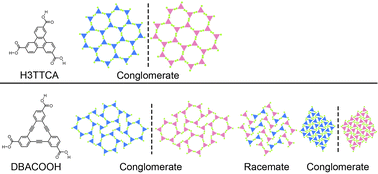Influence of core size on self-assembled molecular networks composed of C3h-symmetric building blocks through hydrogen bonding interactions: structural features and chirality†
Abstract
The effect of the core size on the structure and chirality of self-assembled molecular networks was investigated using two aromatic carboxylic acid derivatives with frameworks displaying C3h symmetry, triphenylene derivative H3TTCA and dehydrobenzo[12]annulene (DBA) derivative DBACOOH, each having three carboxy groups per molecule. Scanning tunneling microscopy observations at the 1-heptanoic acid/graphite interface revealed H3TTCA exclusively forming a chiral honeycomb structure, and DBACOOH forming three structures (type I, II, and III structures) depending on its concentration and whether the system is subjected to annealing treatment. Hydrogen bonding interaction patterns and chirality were carefully analyzed based on a modeling study using molecular mechanics simulations. Moreover, DBACOOH forms chiral honeycomb structures through the co-adsorption of guest molecules. Structural diversity observed for DBACOOH is attributed to its relatively large core size, with this feature modulating the balance between molecule–molecule and molecule–substrate interactions.

- This article is part of the themed collection: Nanoarchitectonics Advances: Bridge over Nanotechnology and Materials Science


 Please wait while we load your content...
Please wait while we load your content...